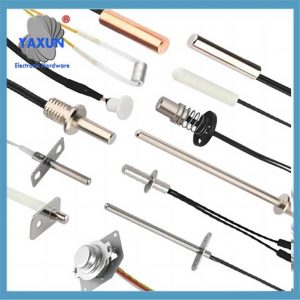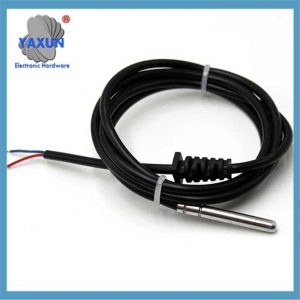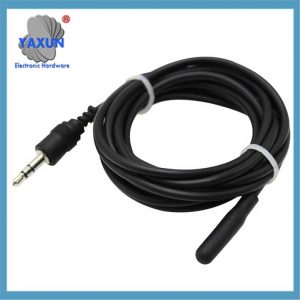NTC (负温度系数) 温度传感器是一种温度测量元件,随着温度升高,热敏电阻的电阻的指数降低. 它的核心是由烧结金属氧化物制成的陶瓷半导体 (例如锰, 钴, 和镍), 并且通过测量电阻变化来推断温度. 以下是其核心技术特征, 应用, 和选择点:
我. 核心特征
工程原理
当温度升高时, 半导体材料的载体浓度和电阻值降低 (负温度系数特性).
电阻 - 温度关系符合steinhart方程: r =, B值 (材料常数) 确定灵敏度.
它是如何运作的:
NTC热敏电阻使用负温度系数原理, 材料的电阻随温度升高而降低. 这种关系通常是非线性的.
KEY参数
标志性 (R25): 25°C的参考电阻 (例如5kΩ, 10千欧姆, 100千欧姆).
B值: 反映温度灵敏度 (常见的3435k, 3950K, ETC。), 价值越高, 灵敏度越强.
热时间常数: 响应速度指示器 (毫秒到几秒钟).
准确性: 工业级可以达到-20°C 〜85°C的范围±0.1°C。.
结构特征
它由NTC芯片组成, 保护性壳 (金属/塑料), 导线和终端, 并采用双层封装过程,以改善密封和抵抗机械损坏.
柔性尺寸 (最小直径 0.01 英寸), 支持定制设计.
优点:
NTC热敏电阻以其对温度变化的高灵敏度而闻名, 紧凑的尺寸, 和成本效益.
类型:
NTC热敏电阻有多种形式, 包括芯片, 磁盘, 和拖延版本, 每种表格都有不同的优势和应用.
二. 典型的应用程序场景
消费者电子和家用电器
空调和冰箱的温度反馈控制; 热水器抗干燃烧保护; 洗衣机水温监测.
新的能源车辆和能源存储
电池组温度监测, 电动机过热保护 (需要高温耐热包装和强制输热设计).
工业控制
喷射机温度控制, 加热炉温度校准, 电源设备过热保护.
医师设备
呼吸机气流温度监测, 透析设备液体温度控制, 数字温度计.
其他字段
液位检测 (油箱油水平警报), 电路温度补偿 (抵消晶体管漂移).
III. 选择指南
| 因素 | 参考点 |
| 温度范围 | -50〜〜150℃通用目的; >150℃需要特殊包装 (例如玻璃密封). |
| 准确性要求 | 对于高精度方案, 选择具有B值一致性±1%和R25公差±1%的模型 (例如MF53系列). |
| 环境适应性 | 用于潮湿/腐蚀性环境, 使用不锈钢防水包装 (例如10K3435探针); 在振动情况下需要抗弯曲导线. |
| 反应速度 | 当需要快速响应时, 选择具有热时间常数的模型 <5s. |
| circut匹配 | 根据系统阻抗选择R25值 (例如10kΩ通常用于5V系统). |
四号. 技术进化方向
材料创新: 金电极芯片提高了高温稳定性 (> 200℃).
一体化: 结合无线传输模块,以实现物联网的远程监控.
热耗散优化: 专利的散热结构可帮助电动汽车电动机在高温环境中可靠运行.
笔记: NTC传感器应在超低温度下避免 (<-50℃) 或超高温度 (300℃) 方案. 对于这种情况, 建议使用热电偶 (类型k) 或RTD410.
 English
English Afrikaans
Afrikaans العربية
العربية বাংলা
বাংলা bosanski jezik
bosanski jezik Български
Български Català
Català 粤语
粤语 中文(简体)
中文(简体) 中文(漢字)
中文(漢字) Hrvatski
Hrvatski Čeština
Čeština Nederlands
Nederlands Eesti keel
Eesti keel Suomi
Suomi Français
Français Deutsch
Deutsch Ελληνικά
Ελληνικά हिन्दी; हिंदी
हिन्दी; हिंदी Magyar
Magyar Bahasa Indonesia
Bahasa Indonesia Italiano
Italiano 日本語
日本語 한국어
한국어 Latviešu valoda
Latviešu valoda Lietuvių kalba
Lietuvių kalba македонски јазик
македонски јазик Bahasa Melayu
Bahasa Melayu Norsk
Norsk پارسی
پارسی Polski
Polski Português
Português Română
Română Русский
Русский Cрпски језик
Cрпски језик Slovenčina
Slovenčina Slovenščina
Slovenščina Español
Español Svenska
Svenska ภาษาไทย
ภาษาไทย Türkçe
Türkçe Українська
Українська اردو
اردو Tiếng Việt
Tiếng Việt



